November 11th, 2012
GL Rotate and translate example (OpenFrameworks)
I consistently seem to get myself confused by the order of operations when working with ofTranslate and ofRotate in openFrameworks and it feels like I have to re-teach myself each time I have to do something with those transforms.
I made this simple bare bones cheatsheet program for myself to help show the differences between different rotate and translate orders, and I hope it helps others…hopefully will get time to post more low level tutorials like this in the near future with some of the more complicated matrix transforms/homography for projection mapping.
Made with xCode and OF0072 but you should be able to just drop the “src” file into a Visual Studio Empty Example if you need to…enjoy!
OF_translate_rotate_cheatsheet (623 downloads)December 19th, 2010
Jit.freenect examples
Download the patch here: Jit.freenect examples (2628 downloads) (or right click and select “Save as”)
Using Jean-Marc Pelletier’s amazing Jit.freenect grab tool I was able to join in on the Microsoft Kinect party. I haven’t made anything nearly as impressive as the myriad of videos flying around youtube and vimeo, but it was fun to play with the depth information for the first time.
I’m more of a max/msp guy, so I just threw together a few examples based on what came to mind in the first few hours of playing with one. Haven’t really touched it with Openframeworks or anything like that yet, but that’s definitely the tool of choice for most people. The first time I played with the tool in Jitter, I had trouble getting the right kind of data treatment in order to get interesting looking things, but this time i was able to cobble together things based on suggestions from users on the Cycling 74 forums. Hopefully my simple experiments will be helpful to someone else. Unfortunately, I was borrowing my kinect so I’m sort of flying blind in terms of updating the example. Hopefully I didn’t break anything when I cleaned it up…
In the example you can get a slice of the depth info and use that as a simple controller, you can control a goofy theremin, map the depth info onto 3d nurbs, and colorize the depth info.
Screenshots are below…I have video, but it’s not very interesting, so a photo will have to do.
(CLICK FOR LARGER VERSION)
November 6th, 2010
Quartz Composer Example: Toss image
When posting Twitfeed and Wiipaint, I forgot about this other example of mine. It was one of my first attempts at using QC 4’s physics patches and it came out pretty well just by messing with the Apple examples. It allows you to give it a folder of images, and based on a simple pulse trigger (in this case, the space bar), it spits out another image on top of the old one. They all kind of pile on top of each other and have a nice, natural spring motion to them. It’s not the cleanest patch in the world, but let me know if you have any questions about deciphering it…a lot of the magic is in JavaScript for ease of logic, but I am the world’s sloppiest JavaScript programmer.
Toss image quartz example (747 downloads)November 4th, 2010
Quartz composer examples: Twitfeed and WiiPaint for VDMX
Just a couple old examples that people used to ask for or could possibly find useful. The first is good ol’ WiiPaint which is a sort of lame way to use a Wiimote with VDMX or quartz composer, but it allows for drawing, erasing and color changes.
WiiPaint (605 downloads)I also made a quick patch out of the RSS feed reader patch in Quartz and set it to search for tweets and display them in real time. It is a good choice for overlays at an event where there is a specific #hashtag. It displays each tweet and allows for control of color, and duration of each tweet, as well as accepting text input for a search term. Enjoy! PLEASE NOTE: DUE TO TWITTER API CHANGES IN JUNE 2013 THE RSS FEED NO LONGER WORKS. Sorry 🙁 Twitfeed quartz comp (1066 downloads)
October 19th, 2010
Jitter example: Lightpainting
In this example, I’m giving you code to do live interactive light painting. The typical way to do this is by taking several extended exposure photographs which are then sequenced into a stop motion video. My method uses jitter to isolate the brightest parts of the scene and then applies additional processing to make it a more interesting experience. Once again, the patch is extremely commented, but let me know if you’re stuck on something. I made the patch for an image processing class originally, so I have some detailed documentation of it. Below the download is a series of images detailing the processing steps to get the lightpainting effect.
Lightpainting example (1535 downloads) (Right click and choose “Save As”)
October 18th, 2010
Jitter example: Color Channel Delay
I’ve always had trouble with the jit.matrixset object so this was sort of an excuse to play with it a little more. Someone had asked a question about this kind of effect on a Cycling 74 forum a few weeks ago, so I decided to try and re-create it recently with pretty decent results. I commented the hell out of it so you should be able to figure out what’s going on if you’re curious. Hopefully this will be the beginning of a series of Jitter examples…I will post lightpainting and the color a sound patch very soon. In the meantime, enjoy this one and let me know if you’re having difficulties in the comments:
Color channel delay example (1128 downloads) (Right click and choose “Save As”)
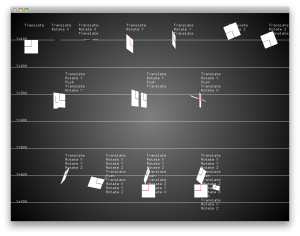
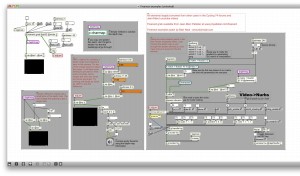
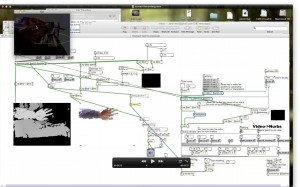
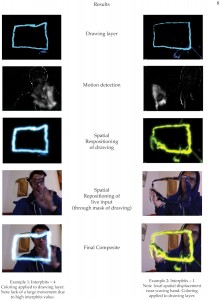


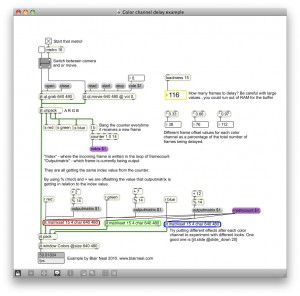
No Comments »